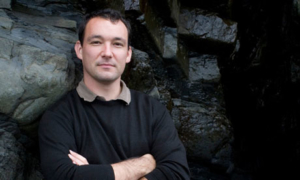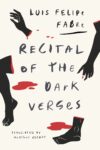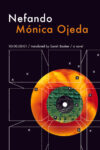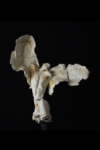 When Coffee House Press dubbed Cynan Jones’s The Dig as a marriage between Cormac McCarthy and Marilynne Robinson, I was immediately intrigued, with both authors having played such a major role in my own writing and reading. I was delighted to see that Coffee House was right, that The Dig marries the beauty-bound surreal cloudiness of Robinson with the visceral violence of McCarthy, reminding me of McCarthy’s earlier work, particularly Outer Dark.
When Coffee House Press dubbed Cynan Jones’s The Dig as a marriage between Cormac McCarthy and Marilynne Robinson, I was immediately intrigued, with both authors having played such a major role in my own writing and reading. I was delighted to see that Coffee House was right, that The Dig marries the beauty-bound surreal cloudiness of Robinson with the visceral violence of McCarthy, reminding me of McCarthy’s earlier work, particularly Outer Dark.
But The Dig is its own animal, and Cynan Jones its tamer. Dealing simultaneously with a brutish badger baiter and a lonely, sympathetic farmer who find each other in a misty, muddy landscape, The Dig is as short and tenacious as a rabid dog and as tender and beautiful as a loving one. Reading it is an experience all its own. Jones writes into the extremes of violence and tenderness, and you, as a reader, feel this in a wholly visceral way.
I had an opportunity to talk with Cynan Jones over the course of a few days via the internet, and he offered some thoughts on his writing and research process for The Dig, as well as his ideas on stories, peripheral detail, and the art of writing itself.
First of all, lovely, lovely book. Could you tell me about the process of writing it, or its conception in your mind? How did the book originate itself for you, and how did it develop over time? It also seems as if there was a fair amount of research into the seeming nuances related to badgers and badger baiters. How did this play into your process?
I wanted to write about the way we try to create a safe space for ourselves and the things we care for, and how something can break into that space. The badger sett provided the perfect allegory. The rest of the book grew from that.
I have first hand experience in the lambing shed but only a peripheral idea of baiting culture. I researched that heavily. It was important not to work on assumptions.
I was greatly helped by the local Badger Watch & Rescue officer, who provided me with photographic evidence of digs and the aftermath of baiting as well as specifics and details. I also tracked down groups using the internet to show off trophy pictures of their dogs and what their dogs had killed. I discovered that people involved in the culture use specific words as codes to each other in seemingly innocent dog breeding forums. I had to persuade them I was one of them, then I’d get a link to a temporary site. I did this only for long enough to know what I thought happened did happen. It wasn’t easy to see some of the pictures.
That’s wild and fascinating. I’m interested in talking more in depth about you having a “peripheral idea” of the baiting culture. This idea of the periphery is something that interests me deeply when it comes to writing. Could you speak on what it means for you to actively pursue the periphery in your mind, to acknowledge it as important, to honor it? You went into such in-depth research to, as you say, not work on the assumption of this peripheral idea, but do you think there is something strong and rich about the things that interest us and catch our vision in the periphery?
I think a thing in the periphery can draw the eye. A dead badger on the road as you drive past in a car. It’s been hit by a car, right? The peripheral leaves us unsure. In the space of unsureness, stories grow. We fill in gaps, make connections, generate reasons for things. The obvious limits us, in terms of that. So yes. I see things here, around me, that provoke questions, start a chain. The peripheral can be an entry point. A gap in the hedgerow we can’t resist, a crack in the door.
The layout of the novel, in these tight, compressed paragraphs, calls to mind an interview with Don DeLillo at The Paris Review, where he mentions that he used to (or still does) write just one paragraph on a page, thinking of the paragraph as its own fundamental unit. Is this something you think about, as well? Or am I just grasping for straws over here?
Absolutely. Even on a sentence level. Every word should be doing something. Even if that’s just giving a reader space to breathe.
Much of my work can be broken down into smaller stand-alone pieces of writing. For example, the central section of the novel, where the father takes his son on a dig, was published in Granta Magazine as a short story in its own right. It landed on the shortlist of the Sunday Times EFG Private Bank Short Story Award. I don’t accept the rhetoric that “a short story is not part of a longer story” — life happens to us in self-contained moments of different lengths. A narrative can reflect that.
Coffee House dubs The Dig as a marriage between Cormac McCarthy and Marilynne Robinson. How do you feel about this comparison, and who do you admire and draw from in your own writing? To me, The Dig also calls to mind Peter Matthiessen’s Far Tortuga, or Ondaatje’s The Collected Works of Billy the Kid, even the starkness of someone like László Krasznahorkai. Was it a conscious decision on your part to pare down the length of the novel? Did the novel fight that urge or did that seem to come naturally as you moved through it?
I was under pressure to “write a longer book.” The Dig was originally the second part of a longer work, the first part of which was set in 1940s wartime Wales. For that second part, I wrote the narrative of the badger baiter and Daniel’s narrative separately then brought them together. For a long time there was a third character “watching” them both, who was a link to the first story.
When my agent read the whole thing through, he recognised the real story was the story of the badger baiter and the farmer. The rest had to go. Even if that meant the book would, again, be a short (and more difficult to sell) novel. Eighteen months worth of work and 60,000 words were cut in one fell swoop to leave the second part only. Eventually, the third character also disappeared. But I think it’s possible for the things cut from a story to continue to echo through the narrative.
Speaking of Ondaatje, in his novel In the Skin of a Lion, he writes that the first sentence of every novel should be: “Trust me, this will take time but there is order here, very faint, very human.” I’ve been thinking about him in regards to your own work, and thinking about this notion, too. How do you approach order in your work, and time?
I try to deliver an immediate and clear idea of what the reader is in for from the very first sentence. A sense of what is to come. That is vital in persuading the reader to invest their time, to trust the writing, and wait.
A story generally happens for me in my head before I go anywhere near the desk. I try to see it first, completely, then — when I can more or less replay it over and over — I sit down and try to write it as strongly as I can.
The initial process is often very quick, and very intense. The process of getting the story onto the page. The more elusive things come next — the order, timing, tensions, paring away. Structure is absolutely key, and often the result of instinctive choice.
There are scenes of violence peppered throughout your novel. Perhaps the most striking and writhing one, of the lamb’s miscarriage, is also a scene of remarkable tenderness. As a reader, I feel this contrast between violence and tenderness heavily, and it keeps me in a state of constant deepening. A lot of literature seems to resist both the saccharine and the violent, and yet your work pushes at the bounds of those things and becomes both compassionate and ruthless. Do these sort of themes play out in your mind as you write? Do you feel that draw, and, at the same time, that resistance to go to those places of extreme love and extreme brutality?
I don’t feel drawn specifically to tell violent stories, and I try to be careful not to use brutality as a quick narrative fix. But something compelling has to happen in a story, and enthrall a reader. Often, that capturing trigger, or result, is brutal or moving. My job is to understand what would really happen in any given circumstance and then write it clearly and strongly.
If you choose to write a story about a man who sets dogs on other animals, and the fundamental processes of birth, you can’t shy away from the blood and guts of those processes. I trust the reader to be able to understand the horror and tenderness innate in a situation. My job is to write it down as clearly as I can, and without judgement. There’s a difference between voyeurism and witness.
Talk to me about language. There’s a cadence and rhythm to your sentences, and also this oft-kilter thing you do with making up words, like “missingness.” At one point, you talk about “the way things gather names,” and your writing has this same sort of grassroots feel to it, that you’re not searching for the right word for the meanings you are reaching for, but rather letting the language sort of guide your way toward meaning. Can you talk about this? About how you approach language, and turn it and move it and turn it again?
So much depends on instinct. To write well you have to get yourself into a place where you’re not overly concerned about the correctness of a thing. You also need to be technically good enough not to struggle to find words, whether those words really exist or not.
When it comes to reading over what you’ve written, some of the incorrectnesses don’t fit — they’ve done their job of moving the narrative forward at the time of writing, but are redundant after that. Other incorrectnesses work, and stay.
There’s very little movement in your novel; for the most part, it is a novel of stillness punctuated by moments of sharp, visceral detail. What are your thoughts on stillness in literature today? Do you think it’s a necessary construct, and do you feel that in today’s world it becomes a harder or easier moment to write into?
The story is god. Some stories demand pace, movement, scope; others claustrophobia, traps, stillnesses, silence. You have to know the story you’re trying to tell. If you arrive at the desk with academic concepts as the primary thing they can poison the work.
In relation to that last question, there’s a moment in your novel where Daniel sees a boy looking at his phone, completely ignoring the “great, dramatic sea” that moves past beside him. It’s a rare moment of technology in a novel that is set deep in a rural landscape, but I loved that moment because I’ve been there, too — in a train rolling along the Hudson River, watching so many people staring deep into their phones while this gorgeous river and these beautiful mountains moved past, right next to us. What is your take on technology, how it’s affecting literature, society, and how it affects you and your work and process?
The stories I’ve generally chosen to tell are about men getting through things, physically. The dilemmas they face, their defeats and wins, mostly have nothing to do with the point in time the story is set at. They are timeless things, answered in the same way they would have been for centuries whatever trappings of technology are around them. In that respect, I try to demote technology in most of my stories.
In respect to the way new technology is apparently changing literature, and reading, I attempt to remain immune! You can’t be distracted by mores and fads; you just have to belligerently, stubbornly write what you want to.
I do wonder, though, if there is a tangible difference between writing written on a computer screen, writing written on a typewriter, writing written with a pen. Each method has a different physical relationship with the words that appear before you as you write. I write with a pen. The typing up process provides a further editing step. As does the process of printing the work out as a hard copy to start working on with a pen again. These are all vital steps for me.
Perhaps the strongest recurring idea in your novel is the idea of remembrance, and the way things and places can both remember and be remembered, like the way you can walk through a house you know in complete darkness without stubbing your toe. How do you approach landscape in your text, and memory, and this idea of holding onto something and it holding onto you?
First you have to belong to the story. You inhabit it. You have to be able to walk through it without stubbing your toe!
The story is the landscape you walk through and if you see it clearly enough your relationship with its characters is the same as watching people in the world around you — understanding their grief and delight from a specific distance. I don’t write the emotions into the characters as much as acknowledge them being there. The approach to the physical landscape is the same. It’s where the story happens; my eye moves over it. Echoes, implications, the remnants of things exist everywhere and should within the story too, without necessarily being obvious and advertised. In sensing these things, we start to belong to a place. In sensing these, a reader starts to belong to a story.
The Dig is your third novel, but the first to be published in the United States. How does it feel to break into this market, especially with a publisher like Coffee House Press? And how do you feel about smaller, indie publishers, and their rising place in the literature market today?
An overseas deal suggests the heft of a story is strong enough to transmit beyond its specific setting.
I’ve been really thrilled at the publishers across the globe who have taken my work on, and always blown away by their level of care and enthusiasm. Publishers like Coffee House are environmentalists. Without them, good, true, strong, challenging writing is going to die out.
Finally, what’s next for you?
Next, resist the temptation to produce the next novel too quickly!
I’m looking forward to a number of trips on the back of overseas publication, including visits in May to New York and DC. I have some short stories to work on, and a few other projects on the go. Meanwhile, a couple of bigger stories will be vying for place. When one of them gets the upper hand, I’ll take it from there.
Devin Kelly is an MFA student at Sarah Lawrence College, where he serves as the nonfiction editor of LUMINA. His poetry, fiction, and essays have appeared or are forthcoming in Armchair/Shotgun, Post Road, RATTLE, The Millions, Appalachian Heritage, Midwestern Gothic, Forklift Ohio, Big Truths, Passages North, and more, and he has also been nominated for a Pushcart Prize. He co-hosts the Dead Rabbits Reading Series in Upper Manhattan and teaches Creative Writing and English classes to 7th graders and high schoolers in Queens, as well as the occasional children’s poetry workshop at the New York Public Library in Harlem, where he currently lives. You can find him on Twitter @themoneyiowe and online at devingkelly.wordpress.com.
This post may contain affiliate links.







